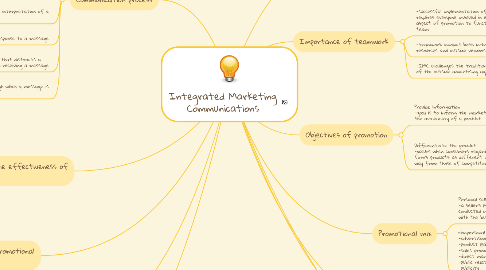Integrated Marketing Communications
Door Crystal Gan


1. Measuring the effectiveness of promotion
1.1. Direct sales results test -based on the specific impact on sales revenues for each dollar of promotional spending
1.2. Indirect evaluation -concentrating on quantifiable indicators of effectiveness such as recall and readership
2. Pulling and pushing promotional strategies
2.1. Pulling strategy -promotional effort by the seller to stimulate final-user demand, which then exerts pressure on the distribution channl Pushing strategy -promotional effort by the seller directed to members of the marketing channel rather than final users
3. Stage in the product lifecycle
3.1. Introduction -nonpersonal and personal selling
3.2. Growth and maturity -advertising and personal selling
3.3. Maturity and early -reduction in advertising and sales promotion
4. Telemarketing -direct marketing conducted entirely by telephone, and it can be classified as either outbound or inbound contacts -for outbound, involves a sales force that contacts customers, reducing the cost of personal visits -for inbound, it involves a customer initiating the call, usually through a toll-free number
5. Communication process
5.1. Sender -seeks to convey a message to the receiver
5.2. Message -communication of information, advice, or a request by the sender to the receiver -the receiver decodes, or interprets, the message and sends feedback
5.3. Encoding -translating a message into understandable terms
5.4. Decoding -receiver's interpretation of a message
5.5. Feedback -receiver's response to a message
5.6. Noise -any stimulus that distracts a receiver from receiving a message
5.7. Channel -medium through which a message is delivered
6. Direct mail -many forms like sales letters, postcards, brochures, booklets, catalogs, house organs, and DVDs
7. Direct marketing -helps increase store traffic -opens new international markets of unprecedented size
8. Sponsorships -organizations provide money or in-kind resources to an event or activity in exchange for a direct association with that event or activity
9. Promotional mix
9.1. Personal selling -a seller's promotional presentation conducted on a person-to-person basis with the buyer
9.2. Nonpersonal selling -advertising -product placement -sales promotion -direct marketing -public relations -publicity
10. Objectives of promotion
10.1. Provide information -goal is to inform the market about the availability of a product
10.1.1. Increase demand -may increase primary demand-the desire for a general product category -may increase selective demand-the desire for a specific brand
10.2. Differentiate the product -occurs when consumers regard a firm's products as different in some way from those of competitors
10.2.1. Accentuate the product's value -greater value helps justify a higher price in the marketplace -marketers must choose their words wisely when creating messages that accentuate their products's value
